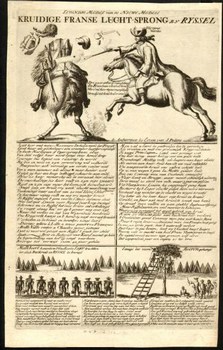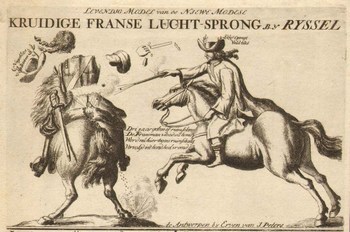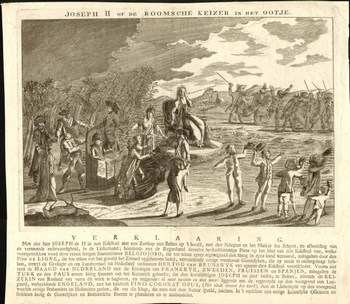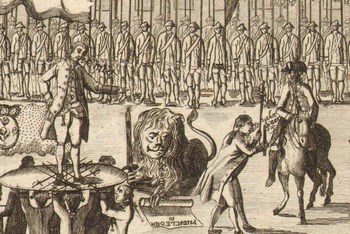|
A group of
satirical prints from the 18th century
All about troubles in the Low country's with their
occupiers
|
Satire on Emperor Joseph II
- 1781 |
Around 1780 a revolt in the Low country's against his power started and he had to pull forces away from the Turkish Battle. He was called: Keizer-Koster (Emperor-sexton)
Joseph II (Joseph
Benedikt Anton Michael Adam; 13 March 1741 – 20 February 1790)
was Holy Roman Emperor from 1765 to 1790 and ruler of the
Habsburg lands from 1780 to 1790. He was the eldest son of
Empress Maria Theresa and her husband, Francis I. He was thus
the first ruler in the Austrian dominions of the House of
Lorraine, styled Habsburg-Lorraine (von Habsburg-Lothringen in
German). Joseph was a proponent of enlightened absolutism;
however, his commitment to modernizing reforms subsequently
engendered significant opposition, which eventually culminated
in an ultimate failure to fully implement his programmes. He has
been ranked, with Catherine II of Russia and Frederick II of
Prussia, as one of the three great Enlightenment monarchs.[1]
His policies are now known as Josephinism. He died sonless and
was succeeded by his younger brother, Leopold. |
Allegory on the waste
educator, with 'the Duke of Brunswijk, also called 'The Fat Duke'
- 1784 |
|
The "Boerekrijg" (Farmers' Revolt) - Flanders - 1798 |
 |

|
||||||||
|
One of the terrible consequences of the French occupation starting in 1795 was the introduction of obligatory military service. Unmarried men between 16 and 25 had to enlist in the army for a period of 5 years in peace time and for an indefinite period while at war. Things military and the job of war making weren't exactly the most respected careers. Most preferred to be their own master and were averse to soldiering. That might very well have something to do with the fact that so many times our regions had been subjected to the pillage and destruction by gangs of lawless foreign soldiers totally out of control and with respect for nothing or no one. And now our boys had to serve in far off countries in the army of the occupant whose language they didn't speak. Perhaps to go do there what they had condemned here: when they ran out of provisions they had to take from the locals if they wanted to survive. Blind obedience was demanded and anything other than blind obedience by the cannon fodder was severely punished. Soldiers were expendable, some were perhaps more equal than others but many of them were no doubt not always looked after too well. In fact there was an appalling indifference to the suffering of the wounded who were routinely abandoned on the battlefields. A small wound or a minor illness was often fatal and there were so many accidents with horses, cannon and gunpowder. So many young men never returned and year after year more soldiers were needed and more taxes were raised. (Nor was France the only country to treat its cannon fodder in this way. 25 October 1798 is usually given as the starting date for the revolt. Secret preparations had been underway for months. But due to a spontaneous outburst of fury, due to the umpteenth seizure because of an overdue tax payment by an inhabitant of Overmere it started in fact two weeks early on 12 October 1798 in that village half way between Ghent and Dendermonde. A band of Brigands as they were called, tried to reach the mouth of the Schelde river where aid from Britain was expected. Two attempts to land the aid failed. Too little too late? And/or politics as usual? In West-Flanders (nearest France) the revolt was broken after an early heavy defeat in Ingelmunster (200 dead). In South-East-Flanders the resistance was already broken on 20 October. Mechelen (Mechlin, Malines) is occupied by the Brigands on 22 October but already lost the next day when 41 prisoners are shot at the foot of the tower of the St Rombouts Cathedral. In Klein-Brabant, the Brigands are successful at the outset. They hold the old fortress of St Margrets near the mouth of the Rupel river for more than 14 days under the leadership of Emmanuel Rollier from St. Amands. There are furious battles in Dendermonde, Boom, Lier, Willebroek and finally on 5 November in Bornem where the battle once again degenerates into plundering and looting while 88 houses go up in smoke and flames. In the Kempen (Campine) region the leader is Jozef Van Gansen from Westerlo. The revolt starts in Geel on 15 October. A big army of Brigands controls the regions of Westerlo, Geel, Mol and the fortified abbey of Tongerlo. There are battles at Diest, Turnhout and Herenthals. But after the fall of this last city the Brigands pull back deep into the Campine country. In the Hageland the leader is Eelen, the son of a physician from Scherpenheuvel. Zoutleeuw and Tienen are conquered from the French but a battle is lost near Leuven (Louvain) on 28 October. In a surprise attack a 600 strong force of Brigands take the city of Diest but they are immediately besieged by a much larger well equiped French army. Van Gansen is wounded. Meulemans, a surveyor from Tongerlo, leads the rebels quietly out of the city in the dead of night along a narrow dike through inundated fields along the Demer river, to the great surprise of the French. Gangs of refuseniks and deserters took to the hills and forests and fought the French occupants in a guerilla war. And the much better equiped French showed no mercy and quite often took no prisoners. And this violent repression of the revolt in its turn added to the anger. |
|||||||||


